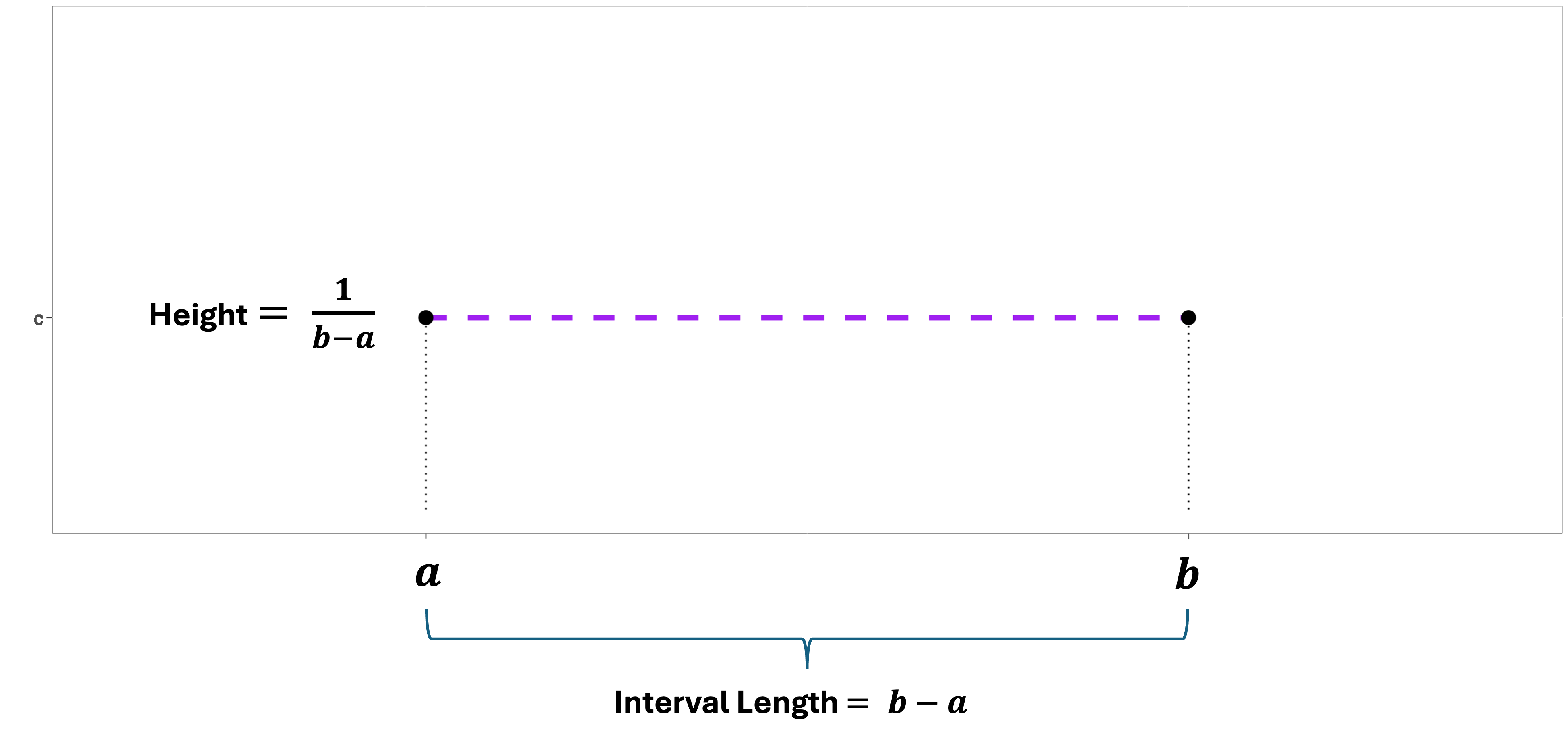Slides 📊
6.5. Uniform Distribution
After exploring the mathematical elegance and complexity of the normal distribution, we now turn to perhaps the simplest of all continuous distributions: the uniform distribution.
Road Map 🧭
Understand the uniform distribution as representing constant probability density over a fixed interval.
Develop geometric intuition for probability as rectangular areas.
Learn the mathematical formulation of uniform PDF and CDF, and explore the key properties.
6.5.1. The Essence of Uniform Randomness
A uniform distribution assigns equal probability density to every point within its support interval \([a, b]\) for some \(a < b\).
The Uniform PDF
A continuous random variable \(X\) is said to follow a uniform distribution on the interval \([a, b]\) if it has a probability density function of the following form:
We write \(X \sim \text{Uniform}(a,b)\) or sometimes \(X \sim U(a,b)\).

Fig. 6.20 A Uniform PDF
Determining the Constant Height
The constant \(\frac{1}{b-a}\) isn’t arbitrary—it’s the unique value that makes the PDF valid. Since the distribution forms a rectangle with base \((b-a)\) and height \(c\), the total area is \(\text{Area} = \text{base} \times \text{height} = (b-a) \times c\). For this to equal 1, we need:
This geometric argument shows why the height must be the reciprocal of the interval length.
The Uniform CDF
The cumulative distribution function for a uniform distribution increases linearly from 0 to 1 over the support interval:

Fig. 6.21 A Uniform CDF
Deriving the CDF
Before the rectangle begins, zero area is accummulated on the PDF. Thus the CDF is 0 for \(x < a\).
After the rectangle is complete, all existing area in the PDF has been accummulated. The CDF is 1 for \(x \geq b\).
For an \(x\) between \(a\) and \(b\), the CDF represents the size of the area under the PDF from \(-\infty\) to \(x\). Since the PDF is zero below \(a\) and constant at height \(\frac{1}{b-a}\) from \(a\) to \(x\), this region forms a rectangle with the width \(x-a\) and the height \(\frac{1}{b-a}\). Therefore,
6.5.2. The Length Principle
Since the uniform PDF has constant height \(\frac{1}{b-a}\) across its support, the probability of any interval equals the area of the corresponding rectangle:
Notice that this probability depends only on the interval length \((d-c)\) and the total support length \((b-a)\). The specific values of \(c\) and \(d\) don’t matter—only how far apart they are.
Example💡: Unifrom Probabilities
Consider \(X \sim \text{Uniform}(0, 10)\).
Find \(P(1 \leq X \leq 3)\).
\[P(1 \leq X \leq 3) = \frac{3-1}{10-0} = \frac{2}{10} = 0.2\]Find \(P(4.7 \leq X \leq 6.7)\).
\[P(4.7 \leq X \leq 6.7) = \frac{6.7-4.7}{10-0} = \frac{2}{10} = 0.2\]Note that the two intervals in #1 and #2 have the same length. they also share the same probability.
Find \(P(8.5 \leq X \leq 10.5)\).
\[\begin{split}P(8.5 \leq X \leq 10.5) &= P(8.5 \leq X \leq 10) + P(10 < X \leq 10.5)\\ &= \frac{1.5}{10} + 0 = 0.15\end{split}\]🛑 The interval in this probability statement extends beyond the support. Our calculation must reflect the fact that the probability of \(X\) taking any value greater than 10 is zero. This is an important example that highlights the role of the support in probability calculations.
6.5.3. Expected Value and Variance of Uniform Distribution
The uniform distribution’s symmetry and rectangular shape make its expected value geometrically obvious, while its variance can be computed through either geometric reasoning or algebraic integration.
Expected Value: The Midpoint
By symmetry, the expected value of a uniform random variable must lie at the center of its support:
Algebraic Verification of Expected Value
We can confirm this geometric insight through integration:
Variance
For variance, we’ll use the computational formula \(\text{Var}(X) = E[X^2] - (E[X])^2\). We already know \(E[X]\), so we need to find \(E[X^2]\):
Now we use the algebraic identity \(b^3 - a^3 = (b-a)(b^2 + ab + a^2)\):
Finally, we compute the variance:
The Result
The variance and standard deviation of a uniform distribution is:
The variance depends only on the length of the support interval \((b-a)\)—wider intervals create more variability.
Example💡: Expectation, SD, and Percentile of a Uniform Random Variable
Suppose a factory produces metal bolts with diameters that fall between 10 mm and 30 mm evenly. Find the expected value, standard deviation, and the 25th percentile of the diameters.
Let \(X\) denote the diameters of metal bolts. \(X \sim \text{Uniform}(10, 30)\).
For the 25th percentile \(x_{0.25}\), we must solve \(F_X(x_{0.25})=0.25\).
\[\frac{x_{0.25}-a}{b-a} =0.25 \implies x_{0.25} = 10 + 0.25(30-10) = 10 + 5 = 15\]25% of the bolts produced in this factory has a diameter less than or equal to 15 mm.
6.5.4. Summary: Properties of Unifrom Distribution
Notation: \(X \sim \text{Uniform}(a,b)\) or \(X \sim U(a,b)\)
Parameters: \(a\) (lower bound) and \(b\) (upper bound), where \(a < b\)
Support: \([a, b]\)
PDF: \(f_X(x) = \begin{cases} \frac{1}{b-a} & \text{for } a \leq x \leq b \\ 0 & \text{elsewhere} \end{cases}\)
CDF: \(F_X(x) = \begin{cases} 0 & \text{for } x < a \\ \frac{x-a}{b-a} & \text{for } a \leq x \leq b \\ 1 & \text{for } x > b \end{cases}\)
Expected Value: \(E[X] = \frac{a+b}{2}\)
Variance: \(\text{Var}(X) = \frac{(b-a)^2}{12}\)
Standard Deviation: \(\sigma_X = \frac{b-a}{\sqrt{12}}\)
6.5.5. Bringing It All Together
Key Takeaways 📝
The uniform distribution represents constant probability density across a fixed interval, making it one of the simplest continuous distributions.
Only interval lengths matter for uniform probability calculations, as long as the interval is entirely inside the support.
The PDF height \(\frac{1}{b-a}\) ensures that the rectangular area equals 1.
The CDF increases linearly from 0 to 1 across the support.
Expected value equals the midpoint \(\frac{a+b}{2}\), and variance equals \(\frac{(b-a)^2}{12}\).
Exercises
Basic Properties: For \(X \sim \text{Uniform}(2, 8)\):
Find \(P(3 \leq X \leq 5)\).
Find \(P(X > 7)\).
Find the median and verify it equals the mean.
Calculate the variance and standard deviation.
Manufacturing Application: A cutting machine produces rods with lengths uniformly distributed between 49.8 and 50.2 cm.
What’s the probability a rod meets specifications \([49.9, 50.1]\) cm?
Find the 90th percentile of rod lengths.
If specifications are tightened to \([49.95, 50.05]\) cm, what percentage will meet the new requirements?
Conditional Probability: For \(X \sim \text{Uniform}(0, 10)\):
Find \(P(X > 7 | X > 5)\).
Find \(P(2 < X < 6 | X < 8)\).
Explain how the length principle applies to conditional probabilities.
Finding parameters: If a uniform distribution has a mean of 15 and a variance of 12, find the parameters \(a\) and \(b\).